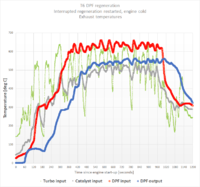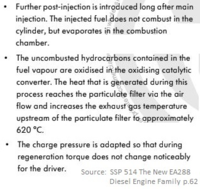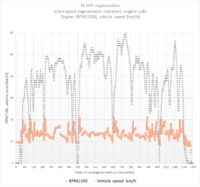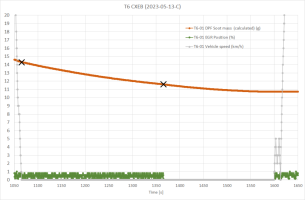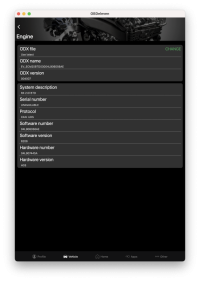Got curious how T6 copes with doing short journeys. And how short would be too short for successful DPF (Diesel Particulate Filter) regeneration.
The graphs below are result of doing short journeys - the plotted one is number 3, thus two interrupted DPF regens before this. At this stage the regen was about halfway through - the DPF regen process was initiated at soot level of approx. 30 grams. The engine is T6 CXEB with recently updated software. Among other things, the DPF regeneration process was altered with the update.
I believe (based on quite a few similar samples) the case here is pretty much "worst case" scenario because outdoor temperature was -1C, city driving (see speed and RPM plots further down).
Picture 1.
Soot level vs. time, including EGR (Exhaust Gas Recirculation) valve position data. The latter just to indicate when the active DPF regeneration takes place.
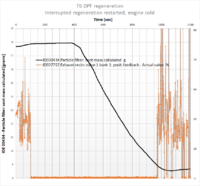
Picture 2.
The exciting part - the DPF heat-up phase. This is just a subplot of the above - first 480 seconds = 8 minutes.
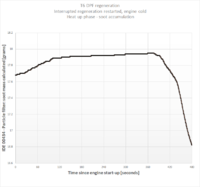
The conclusion: approx. 7 minutes is needed to get back at same soot level as at engine startup. By doing only shorter journeys the soot level would keep going up, eventually turning DPF warning light on. The exact level for T6 to be defined... assuming to be 35 grams.
Picture 3. Exhaust temperatures along the exhaust
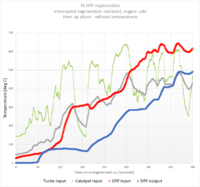
Picture 4. Driving conditions during heat up phase.
Outdoor temperature -1C.
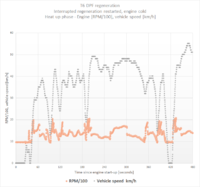
NOTE: Elevated tick over for first 25 seconds is because of cold weather, not because of pending DPF regen.

 www.t6forum.com
www.t6forum.com
Comments? Anything else?
The graphs below are result of doing short journeys - the plotted one is number 3, thus two interrupted DPF regens before this. At this stage the regen was about halfway through - the DPF regen process was initiated at soot level of approx. 30 grams. The engine is T6 CXEB with recently updated software. Among other things, the DPF regeneration process was altered with the update.
I believe (based on quite a few similar samples) the case here is pretty much "worst case" scenario because outdoor temperature was -1C, city driving (see speed and RPM plots further down).
Picture 1.
Soot level vs. time, including EGR (Exhaust Gas Recirculation) valve position data. The latter just to indicate when the active DPF regeneration takes place.

Picture 2.
The exciting part - the DPF heat-up phase. This is just a subplot of the above - first 480 seconds = 8 minutes.

The conclusion: approx. 7 minutes is needed to get back at same soot level as at engine startup. By doing only shorter journeys the soot level would keep going up, eventually turning DPF warning light on. The exact level for T6 to be defined... assuming to be 35 grams.
Picture 3. Exhaust temperatures along the exhaust
Green = engine exhaust manifold, entering turbo.
Grey = turbo output, entering catalytic converter
Red = catalytic converter output, entering DPF
Blue = DPF output
Data from IDE04090 - Exhaust temperature bank 1. Exhaust details p.27 onwards in SSP 564 - The T6 2.0L TDi

Picture 4. Driving conditions during heat up phase.
Outdoor temperature -1C.
Orange = Engine RPM/100 (during heat up average 1350 rpm, decided by DSG).
Grey = Vehicle speed (during heat up average 34 km/h)

NOTE: Elevated tick over for first 25 seconds is because of cold weather, not because of pending DPF regen.
Another one in series "[T6_measured]" -

[T6_measured] Fickle fuel consumption on MFD – encore
In March 2020 finally got the long-awaited ECU (Engine Control Unit) software update. Unfortunately it took a while to get a good chance to do some measurements to try to figure out what has been changed. So finally a few weeks back dusted the VCDS and collected all kind of intriguing data. The...
Comments? Anything else?

